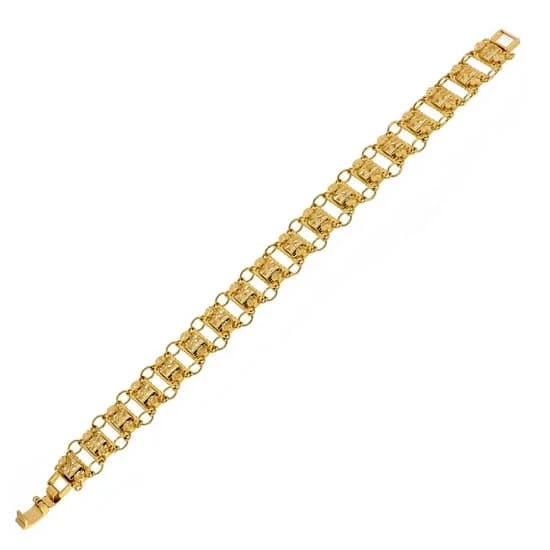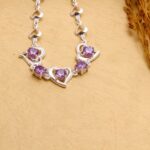Is 10K gold acceptable for fine jewelry? The use of 10K gold in jewelry making has been a topic of much discussion among industry professionals and consumers alike. In this article, we will explore the composition of 10K gold, how its quality compares to higher karat gold, and its suitability for use in fine jewelry.
Understanding the Karat System is crucial to appreciating the value and beauty of 10K gold jewelry. We will also discuss trends in the use of 10K gold in modern jewelry designs and compare its qualities to other metals commonly used in fine jewelry.
10K gold is an alloy made up of 41.7% pure gold mixed with other metals such as copper, silver, nickel, or zinc. This lower purity level means that 10K gold is more durable and less prone to scratches compared to higher karat gold. However, it also has a lighter color due to the presence of these other metals.
When considering whether 10K gold is acceptable for fine jewelry, longevity and durability are essential factors to examine. Despite being less pure than higher karat gold, 10K gold is still a popular choice due to its affordability and strength. As we delve into the topic further, we will explore consumer considerations and highlight the pros and cons of using 10K gold compared to other metals in fine jewelry.
Understanding the Karat System
10K gold is a popular choice for fine jewelry, but what exactly does it mean? The “K” in 10K stands for karat, which is a measure of the purity of gold. In the karat system, pure gold is considered 24 karats, meaning it is 24 parts gold out of a possible 24 parts. Therefore, 10K gold is made up of 10 parts gold and 14 parts other metals. This composition means that 10K gold is approximately 41.7% pure gold.
When it comes to the karat system, the higher the number of karats, the higher the purity and value of the gold. In contrast, lower karats such as 10K have a lower percentage of pure gold and are often used in jewelry that needs to be more durable. Lower karats are also less expensive, making them a more accessible option for consumers who want to invest in fine jewelry without breaking the bank.
Understanding how the karat system measures gold purity is crucial when shopping for fine jewelry. For those looking for durability and affordability without sacrificing style and quality, 10K gold may be the perfect choice for their next piece of jewelry.
- 24K Gold – 99.9% pure gold
- 18K Gold – 75% pure gold
- 14k Gold – About 58.3% pure gold
- 10k Gold – About 41.7% pure gold
The Quality of 10K Gold
10K gold is composed of 41.7% pure gold and 58.3% other metals, making it more affordable and durable compared to higher-karat gold. This lower purity also means that 10K gold is less prone to scratches and dents, making it a popular choice for everyday fine jewelry pieces such as engagement rings, wedding bands, and necklaces.
Despite its lower gold content, 10K gold is still considered acceptable for fine jewelry. Its durability and longevity make it a practical choice for pieces that will be worn frequently without much worry of damage. Additionally, the lower price point of 10K gold jewelry makes it more accessible to a wider range of consumers without sacrificing quality.
When comparing 10K gold to other karats such as 14K and 18K, the main difference comes down to purity and color. While higher-karat gold may be more valuable due to its higher pure gold content, it is also softer and more prone to scratches. The color of 10K gold is also slightly paler compared to higher-karat options due to the alloy metals used in its composition.
Overall, the durability, longevity, and affordability of 10K gold make it a suitable option for fine jewelry pieces that are meant to be worn regularly while still maintaining their quality and appearance.
| 10k Gold Characteristics | Description |
|---|---|
| Durability | Less prone to scratches and dents |
| Affordability | Lower price point compared to higher karat options |
| Longevity | Suitable for everyday wear without much worry of damage |
Comparing 10K Gold to Other Karats
When comparing 10K gold to other karats such as 14K and 18K, it is important to understand the differences in gold purity and composition. The karat system is used to measure the purity of gold, with 24K being the purest form of gold.
10K gold consists of 41.7% pure gold, with the remaining 58.3% made up of other metals such as copper, silver, or zinc. This lower gold content makes 10K gold more durable and resistant to scratching or bending compared to higher karats.
Here are some key differences between 10K, 14K, and 18K gold:
- 10K Gold: Contains 41.7% pure gold and is more durable due to its higher percentage of alloyed metals.
- 14K Gold: Consists of 58.3% pure gold and is a popular choice for fine jewelry due to its balance between purity and strength.
- 18K Gold: Contains 75% pure gold and has a rich golden color but is softer and may be prone to scratching or bending.
While 10K gold may have a lower gold content compared to other karats, its durability makes it suitable for everyday wear in fine jewelry pieces such as rings, bracelets, and necklaces. Consumers looking for affordable yet long-lasting jewelry options may find that jewelry made with 10K gold is a practical choice.
In modern jewelry designs, there is a growing trend in using 10K gold for both classic and contemporary pieces. Designers are embracing the unique color properties of this alloy to create versatile and stylish jewelry that appeals to a wide range of preferences. When considering fine jewelry options, consumers should take into account their lifestyle, budget, and personal taste when deciding if 10K gold is acceptable for their desired piece.
Trends in Fine Jewelry
When it comes to fine jewelry, the use of 10K gold is becoming increasingly popular in modern designs. This lower karat gold is composed of 41.7% pure gold, making it a more affordable option for consumers while still retaining the luxury and elegance associated with gold jewelry. In recent years, there has been a shift towards more accessible and everyday wearable pieces, and 10K gold fits perfectly into this trend.
Modern Designs With 10K Gold
Designers are embracing the use of 10K gold in their collections, creating modern and trendy pieces that cater to a wider range of consumers. From dainty necklaces to statement earrings, 10K gold is being incorporated into various jewelry styles to meet the demands of fashion-forward individuals.
Affordability and Accessibility
One of the key reasons for the resurgence of 10K gold in modern jewelry designs is its affordability. As compared to higher karat options like 14K or 18K gold, 10K gold offers consumers a more budget-friendly choice without compromising on style or quality. Additionally, the accessibility of 10K gold allows for greater versatility in creating jewelry that can be worn every day without fear of damage or loss.
Consumer Appeal
With more focus on sustainability and value for money, consumers are drawn to the practicality of 10K gold in modern jewelry designs. The durability and longevity of this lower karat option make it an attractive choice for those seeking fine jewelry that can withstand everyday wear. Furthermore, the variety of designs available in 10K gold makes it appealing to a wider audience who may have previously found fine jewelry to be out of reach.
10K Gold vs Other Metals
When it comes to fine jewelry, one of the most important decisions to make is what metal to use. While 10K gold is a popular choice, there are other metals that also have their own advantages and disadvantages.
Pros of 10K Gold
10K gold is prized for its durability and affordability. With its lower gold content (41.7% pure gold), it is more resistant to scratches and dents compared to higher karat gold. This makes it a practical choice for jewelry that will be worn every day, such as engagement rings or wedding bands. Additionally, the lower gold content means it is less likely to tarnish over time.
Cons of 10K Gold
One of the drawbacks of 10K gold is its lower purity compared to higher karat gold. This means that it may not have the same rich color as 14K or 18K gold, which have a higher percentage of pure gold. Some individuals may also be allergic to the alloys used in 10K gold, leading to skin irritation when wearing jewelry made from this metal.
Comparison With Other Metals
In comparison to other metals commonly used in fine jewelry, such as platinum and silver, 10K gold offers a balance between durability and affordability. While platinum is known for its strength and resistance to tarnishing, it is considerably more expensive than 10K gold. Silver, on the other hand, may tarnish easily and can be too soft for certain types of jewelry.
Ultimately, the decision between using 10K gold or another metal in fine jewelry boils down to personal preference as well as budget considerations. Each metal has its own unique characteristics that make it suitable for different types of jewelry designs and wearers’ needs.
Consumer Considerations
When considering whether 10K gold is acceptable for fine jewelry, there are several factors that consumers should take into account. One of the main considerations is the composition of 10K gold, which is made up of 41.7% pure gold and 58.3% other metals. This lower percentage of pure gold means that 10K gold may be more prone to tarnishing or discoloration over time compared to higher karat gold.
In addition to the composition of 10K gold, consumers should also consider the durability and longevity of jewelry made with this type of gold. Due to the higher percentage of other metals, 10K gold is generally stronger and more resistant to scratching or bending than higher karat gold. This makes it a suitable option for everyday wear jewelry such as wedding bands or bracelets.
Another important factor for consumers to consider when purchasing fine jewelry made with 10K gold is their personal style and budget. While 10K gold may not have the same luster or value as higher karat gold, it is a more affordable option, allowing consumers to invest in fine jewelry without breaking the bank.
| Factors to Consider | Importance |
|---|---|
| Composition of 10k Gold | High |
| Durability and Longevity | High |
| Personal Style and Budget | Medium |
Conclusion
In conclusion, the acceptability of 10K gold in fine jewelry is a topic that continues to be debated in the jewelry industry. Despite its lower gold content compared to higher karat gold, 10K gold is still widely used in fine jewelry due to its affordability and durability. Its composition of 41.7% pure gold makes it a suitable choice for those looking for high-quality jewelry at a more budget-friendly price point.
When comparing 10K gold to other karats such as 14K and 18K, it is important to consider the trade-offs. While higher karat gold may have a richer color and higher value, 10K gold may be more resistant to scratching and bending, making it ideal for everyday wear. Modern trends in fine jewelry also show an increased use of 10K gold in contemporary designs, appealing to a wider range of consumers who are looking for versatile and stylish pieces.
Ultimately, the acceptability of 10K gold in fine jewelry depends on the preferences and priorities of the individual consumer. Factors such as budget, lifestyle, and personal style should all be taken into consideration when deciding whether 10K gold is the right choice for a piece of fine jewelry. As with any significant purchase, thorough research and consultation with a reputable jeweler can help ensure that consumers make an informed decision that aligns with their needs and desires.

Welcome to my jewelry blog! My name is Sarah and I am the owner of this blog.
I love making jewelry and sharing my creations with others.
So whether you’re someone who loves wearing jewelry yourself or simply enjoys learning about it, be sure to check out my blog for insightful posts on everything related to this exciting topic!





